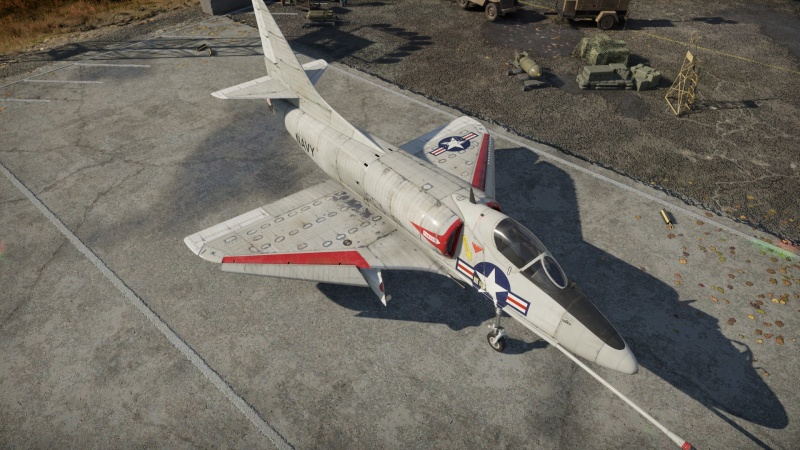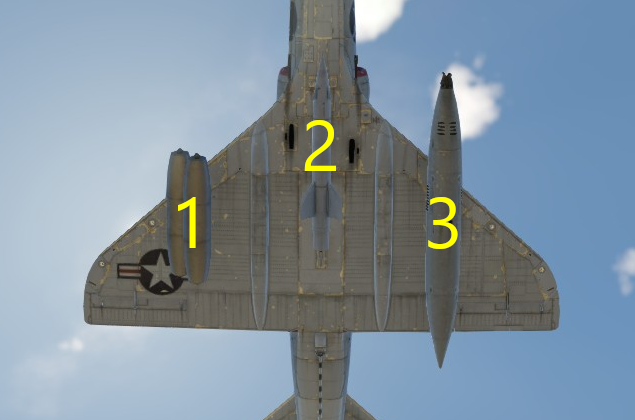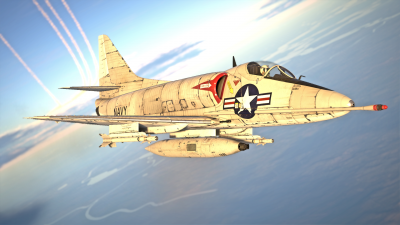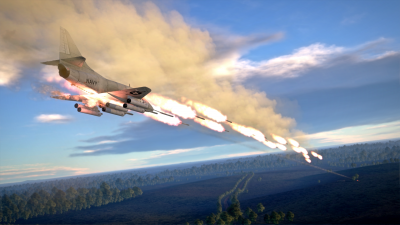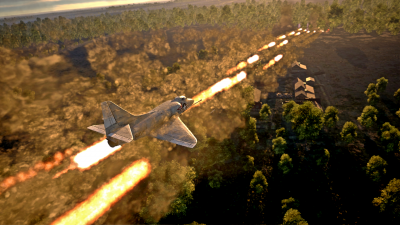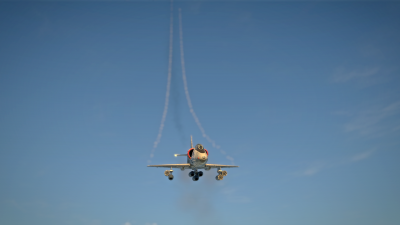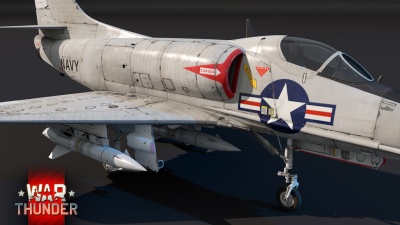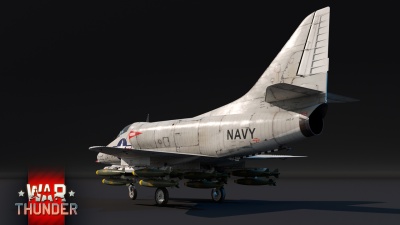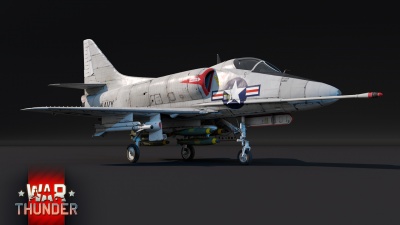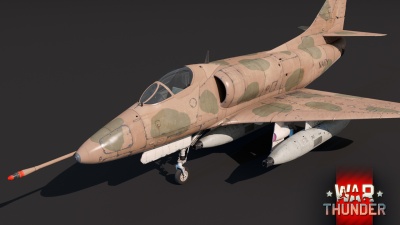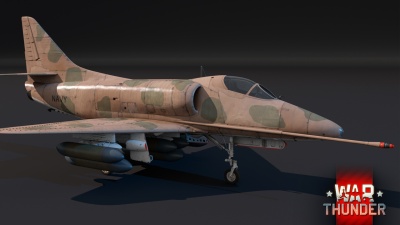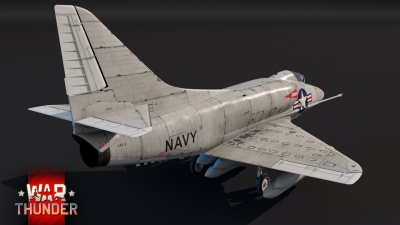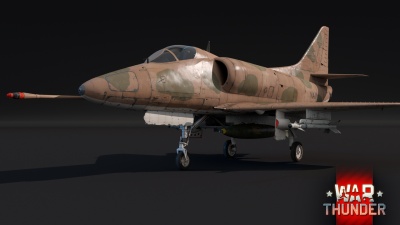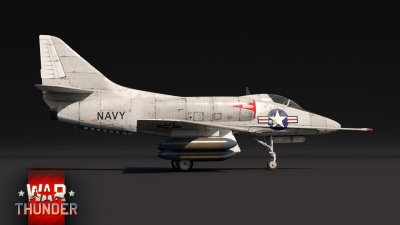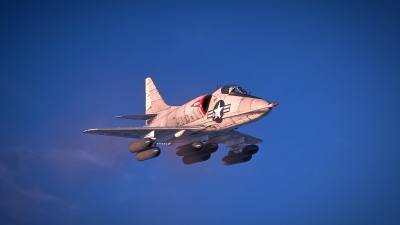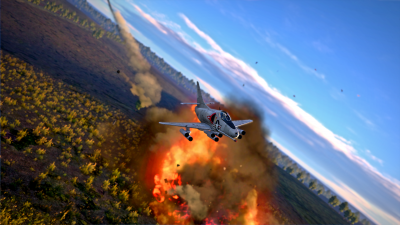Difference between revisions of "A-4B"
m (→External links) |
(→Description) |
||
| (39 intermediate revisions by 14 users not shown) | |||
| Line 1: | Line 1: | ||
| + | {{About | ||
| + | | about = American strike aircraft '''{{PAGENAME}}''' | ||
| + | | usage = other versions | ||
| + | | link = A-4 (Family) | ||
| + | }} | ||
{{Specs-Card | {{Specs-Card | ||
|code=a_4b | |code=a_4b | ||
| Line 6: | Line 11: | ||
== Description == | == Description == | ||
<!-- ''In the description, the first part should be about the history of and the creation and combat usage of the aircraft, as well as its key features. In the second part, tell the reader about the aircraft in the game. Insert a screenshot of the vehicle, so that if the novice player does not remember the vehicle by name, he will immediately understand what kind of vehicle the article is talking about.'' --> | <!-- ''In the description, the first part should be about the history of and the creation and combat usage of the aircraft, as well as its key features. In the second part, tell the reader about the aircraft in the game. Insert a screenshot of the vehicle, so that if the novice player does not remember the vehicle by name, he will immediately understand what kind of vehicle the article is talking about.'' --> | ||
| − | The ' | + | The A-4B was a compact and lightweight attack aircraft designed by Ed Heinemann of Douglas Aircraft Company in response to the U.S. Navy's need for a cost-effective and agile attacker. It was a successful solution for the Navy, offering simplicity, low weight, and ease of maintenance. Despite its small size, the A-4 was a capable aircraft, equipped with two 20mm autocannons and various hardpoints for missiles, rockets, and bombs. It played a significant role in the Vietnam War as the primary light bomber for the Navy. With over 540 A-4Bs manufactured, it featured upgrades like improved navigation equipment and the AGM-12 Bullpup missiles. The A-4 remained in service for over 20 years and continues to be operational in some countries like Brazil and Argentina even after six decades since its inception |
| − | |||
| − | |||
| − | |||
| − | |||
| − | |||
| − | |||
| − | + | It was introduced in [[Update 1.97 "Viking Fury"]]. The {{PAGENAME}} is an excellent aircraft for pilots who like to perform multiple roles without having to switch up aircraft. Possessing options to carry up to 5,000 lbs in bombs, 133 unguided rockets or five 20 mm autocannons with a total of 2,350 rounds of ammunition in what is effectively a "hot rod" of the jet world allows pilots to maximize their playstyle. Though the manoeuvrability suffers when fully loaded, this jet attacker operates well at mid and lower altitudes, especially when unloading bombs and rockets on ground-based targets | |
== General info == | == General info == | ||
| Line 20: | Line 19: | ||
{{Specs-Avia-Flight}} | {{Specs-Avia-Flight}} | ||
<!-- ''Describe how the aircraft behaves in the air. Speed, manoeuvrability, acceleration and allowable loads - these are the most important characteristics of the vehicle.'' --> | <!-- ''Describe how the aircraft behaves in the air. Speed, manoeuvrability, acceleration and allowable loads - these are the most important characteristics of the vehicle.'' --> | ||
| + | |||
| + | The A-4B is a carrier-based light attack aircraft. Its powerplant is the Wright J65-W-16A engine that can produce up to 3,200 kgf of thrust giving it good thrust to weight ratio. At sea level it can reach up to 1063 km/h, that puts it on par with the planes like a MiG-15 and M.D.452, while other planes like a G.91 or Swift F.1 are faster by up to 20 km/h. Its structural speed is over 100 km/h higher, however it does not remain controllable near that speed anymore. | ||
| + | Its climb rate is decent, getting to 6,000 m will take about 3 minutes, slightly worse than the F-86F-25 and other dedicated interceptors, for example the MiG-15. The plane accelerates very well, the thrust to weight ratio is 0.47 with full fuel tanks and can be increased to 0.59 after loading 20 minutes of fuel, that means it can outaccelerate a F-86F or F9F-8 at low and medium speed. The engine does not overheat so fast: it can operate for 30 minutes on maximum power and up to one hour at 96%. | ||
| + | |||
| + | The A-4B has a low mounted delta wing with slats, it gives the plane decent manoeuvrability and allows it to fly at higher angle of attack than the other planes like the Sabre series, MiG-15 or British Supermarine Swift F.1. Since its wing loading is not so high, its turn rate at low speed is mediocre and it is easy to pull the A-4B too much, make it reach a very high angle of attack and then bleed lots of speed. | ||
| + | In the higher speed range, from medium to high it can give a hard time to many jet fighters including the MiG-17, or G.91 thanks to its very good instantaneous turn rate. However its sustained turn rate compared to these planes is worse, any longer fight will decrease the chance of winning the fight. When turning too tight at high speed there is a risk of breaking a wing, their G limit is very low, with full fuel tanks it can pull up to 8G. The pitch authority is good up to ~1000 km/h, then after that the high speed compression is starting to get noticeable. | ||
| + | The rolling performance is excellent, at 300 km/h IAS it gets close to 200°/s, then increases to almost 300°/s at 500 km/h IAS and reaches 230°/s at 900 km/h, the only planes that can rival it is the Sabre or G.91. | ||
| + | Its airbrake has very similar effectiveness to the one used by the Sabre, so can significantly reduce the speed after being deployed. The flaps can be used up too 600 km/h in the combat position, but cannot be extended above 390 km/h due to a mechanism that blocks them above that speed and makes them extend automatically below it (after setting them to combat or lower positions), however after extending them they will not retract automatically. | ||
| + | |||
| + | In simulator battles it can be a challenging plane to fly due to low G limits, its stall characteristics also might cause a few issues, especially with extended flaps, the speed will keep dropping and it will start rolling to one side after reaching critical angle of attack. Another problem can be its energy retention, it is very easy to pull it too much and unintentionally lose lots of speed. | ||
| + | The plane will need up 8% of positive pitch trimming to keep it in level flight at 900 km/h and lower. | ||
{| class="wikitable" style="text-align:center" width="70%" | {| class="wikitable" style="text-align:center" width="70%" | ||
| Line 61: | Line 71: | ||
! Combat !! Take-off !! Landing !! + !! - | ! Combat !! Take-off !! Landing !! + !! - | ||
|- | |- | ||
| − | | {{Specs|destruction|body}} || {{Specs|destruction|gear}} || | + | | {{Specs|destruction|body}} || {{Specs|destruction|gear}} || 592 || 562 || 410 || ~8 || ~4 |
|- | |- | ||
|} | |} | ||
| Line 79: | Line 89: | ||
|- | |- | ||
! colspan="3" | Engine | ! colspan="3" | Engine | ||
| − | ! colspan=" | + | ! colspan="5" | Aircraft mass |
|- | |- | ||
! colspan="2" | Engine name || Number | ! colspan="2" | Engine name || Number | ||
| − | ! colspan=" | + | ! colspan="2" | {{Annotation|Basic mass|Mass of the aircraft with pilot and engine oil, but no fuel or weapons load}} || colspan="3" | Wing loading (full fuel, no boosters) |
|- | |- | ||
| colspan="2" | Wright J65-W-16A || 1 | | colspan="2" | Wright J65-W-16A || 1 | ||
| − | | colspan=" | + | | colspan="2" | 4,540 kg || colspan="3" | 290 kg/m<sup>2</sup> |
|- | |- | ||
! colspan="3" | Engine characteristics | ! colspan="3" | Engine characteristics | ||
| − | ! colspan=" | + | ! colspan="4" | Mass with fuel (no weapons load, no boosters) || rowspan="2" | Max Takeoff<br>Weight |
|- | |- | ||
! Weight (each) || colspan="2" | Type | ! Weight (each) || colspan="2" | Type | ||
| − | ! | + | ! 13m fuel || 20m fuel || 30m fuel || 45m fuel |
|- | |- | ||
| 1,270 kg || colspan="2" | Axial-flow turbojet | | 1,270 kg || colspan="2" | Axial-flow turbojet | ||
| − | | 5, | + | | 5,280 kg || 5,620 kg || 6,160 kg || 7,008 kg || 10,206 kg |
|- | |- | ||
| − | ! colspan="3" | {{Annotation|Maximum engine thrust @ 0 m (RB / SB)|The maximum thrust produced by each engine, while mounted in the aircraft. NOTE: Thrust varies significantly depending on speed & altitude.}} | + | ! colspan="3" | {{Annotation|Maximum engine thrust @ 0 m (RB/SB)|The maximum thrust produced by each engine, while mounted in the aircraft. NOTE: Thrust varies significantly depending on speed & altitude.}} |
| − | ! colspan=" | + | ! colspan="5" | Thrust to weight ratio @ 0 m (100%, no boosters) |
|- | |- | ||
! Condition || 100% || WEP | ! Condition || 100% || WEP | ||
| − | ! | + | ! 13m fuel || 20m fuel || 30m fuel || 45m fuel || MTOW |
|- | |- | ||
| − | | ''Stationary'' || 3, | + | | ''Stationary'' || 3,178 kgf || N/A |
| − | | 0. | + | | 0.60 || 0.57 || 0.52 || 0.45 || 0.31 |
|- | |- | ||
| − | | ''Optimal'' || 3, | + | | ''Optimal'' || 3,213 kgf<br>(200 km/h) || N/A |
| − | | 0. | + | | 0.61 || 0.57 || 0.52 || 0.46 || 0.31 |
|- | |- | ||
|} | |} | ||
| Line 140: | Line 150: | ||
{{Specs-Avia-Suspended}} | {{Specs-Avia-Suspended}} | ||
<!-- ''Describe the aircraft's suspended armament: additional cannons under the wings, bombs, rockets and torpedoes. This section is especially important for bombers and attackers. If there is no suspended weaponry remove this subsection.'' --> | <!-- ''Describe the aircraft's suspended armament: additional cannons under the wings, bombs, rockets and torpedoes. This section is especially important for bombers and attackers. If there is no suspended weaponry remove this subsection.'' --> | ||
| − | |||
| − | |||
| − | |||
| − | |||
| − | The '''''{{PAGENAME}}''''' can | + | The '''''{{PAGENAME}}''''' can be outfitted with the following ordnance: |
| + | |||
| + | {| class="wikitable" style="text-align:center" width="100%" | ||
| + | |- | ||
| + | ! !! width="15%" | 1 !! width="15%" | 2 !! width="15%" | 3 | ||
| + | | rowspan="16" width="30%" | <div class="ttx-image">[[File:Hardpoints_{{PAGENAME}}.png]]</div> | ||
| + | |- | ||
| + | ! [[Mk 11 mod 5 (20 mm)|20 mm Mk 11 mod 5]] cannons (750 rpg) | ||
| + | | 1 || 1 || 1 | ||
| + | |- | ||
| + | ! [[LDGP Mk 81 (250 lb)|250 lb LDGP Mk 81]] bombs | ||
| + | | 6 || 6 || 6 | ||
| + | |- | ||
| + | ! [[Mk 81 Snakeye (250 lb)|250 lb Mk 81 Snakeye]] bombs | ||
| + | | 6 || 6 || 6 | ||
| + | |- | ||
| + | ! [[LDGP Mk 82 (500 lb)|500 lb LDGP Mk 82]] bombs | ||
| + | | 3 || 3 || 3 | ||
| + | |- | ||
| + | ! [[Mk 82 Snakeye (500 lb)|500 lb Mk 82 Snakeye]] bombs | ||
| + | | 3 || 3 || 3 | ||
| + | |- | ||
| + | ! [[LDGP Mk 83 (1,000 lb)|1,000 lb LDGP Mk 83]] bombs | ||
| + | | 1 || 3 || 1 | ||
| + | |- | ||
| + | ! [[LDGP Mk 84 (2,000 lb)|2,000 lb LDGP Mk 84]] bombs | ||
| + | | || 1 || | ||
| + | |- | ||
| + | ! [[LDGP Mk 84 Air (2,000 lb)|2,000 lb LDGP Mk 84 Air]] bombs | ||
| + | | || 1 || | ||
| + | |- | ||
| + | ! [[Mk 77 mod 4 incendiary]] bombs | ||
| + | | 2 || 3 || 2 | ||
| + | |- | ||
| + | ! [[Mk 79 Mod 1 incendiary]] bombs | ||
| + | | 1 || 1 || 1 | ||
| + | |- | ||
| + | ! [[FFAR Mighty Mouse]] rockets | ||
| + | | 38 || 57 || 38 | ||
| + | |- | ||
| + | ! [[Zuni Mk32 Mod 0 ATAP]] rockets | ||
| + | | 8 || 12 || 8 | ||
| + | |- | ||
| + | ! [[AGM-12B Bullpup]] missiles | ||
| + | | 1 || 1 || 1 | ||
| + | |- | ||
| + | ! [[AIM-9B Sidewinder]] missiles | ||
| + | | 1 || || 1 | ||
| + | |- | ||
| + | | colspan="4" | Maximum permissible loadout weight: 2,710 kg<br>Maximum permissible wing load: 1,800 kg | ||
| + | |- | ||
| + | |} | ||
| + | |||
| + | {{Navigation-Start|Default weapon presets}} | ||
| + | {{Navigation-First-Simple-Line}} | ||
* Without load | * Without load | ||
| + | * 2 x AIM-9B Sidewinder missiles | ||
| + | * 133 x FFAR Mighty Mouse rockets | ||
| + | * 28 x Zuni Mk32 Mod 0 ATAP rockets | ||
| + | * 3 x AGM-12B Bullpup missiles | ||
* 18 x 250 lb LDGP Mk 81 bombs (4,500 lb total) | * 18 x 250 lb LDGP Mk 81 bombs (4,500 lb total) | ||
* 9 x 500 lb LDGP Mk 82 bombs (4,500 lb total) | * 9 x 500 lb LDGP Mk 82 bombs (4,500 lb total) | ||
| + | * 18 x 250 lb Mk 81 Snakeye bombs (4,500 lb total) | ||
| + | * 9 x 500 lb Mk 82 Snakeye bombs (4,500 lb total) | ||
* 5 x 1,000 lb LDGP Mk 83 bombs (5,000 lb total) | * 5 x 1,000 lb LDGP Mk 83 bombs (5,000 lb total) | ||
* 1 x 2,000 lb LDGP Mk 84 bomb (2,000 lb total) | * 1 x 2,000 lb LDGP Mk 84 bomb (2,000 lb total) | ||
| − | * | + | * 1 x 2,000 lb LDGP Mk 84 Air bomb (2,000 lb total) |
| − | + | * 7 x Mk 77 mod 4 incendiary bombs | |
| − | + | * 3 x Mk 79 Mod 1 incendiary bombs | |
| − | |||
| − | |||
| − | |||
| − | |||
| − | |||
| − | * | ||
| − | * | ||
| − | |||
| − | |||
| − | |||
| − | |||
| − | |||
* 3 x 20 mm Mk 11 mod 5 cannons (750 rpg = 2,250 total) | * 3 x 20 mm Mk 11 mod 5 cannons (750 rpg = 2,250 total) | ||
| − | + | {{Navigation-End}} | |
== Usage in battles == | == Usage in battles == | ||
<!-- ''Describe the tactics of playing in the aircraft, the features of using aircraft in a team and advice on tactics. Refrain from creating a "guide" - do not impose a single point of view, but instead, give the reader food for thought. Examine the most dangerous enemies and give recommendations on fighting them. If necessary, note the specifics of the game in different modes (AB, RB, SB).'' --> | <!-- ''Describe the tactics of playing in the aircraft, the features of using aircraft in a team and advice on tactics. Refrain from creating a "guide" - do not impose a single point of view, but instead, give the reader food for thought. Examine the most dangerous enemies and give recommendations on fighting them. If necessary, note the specifics of the game in different modes (AB, RB, SB).'' --> | ||
| + | [[File:A-4B an trn 26 007.png|400px|thumb|right|An '''{{PAGENAME}}''' set up for air-to-air combat with its suspended centerline gunpod and AIM-9B Sidewinders.]] | ||
The {{PAGENAME}} while designated by the U.S. Navy as an attacker can work as a multi-role aircraft. Though the variety of armament leans heavily to the attacker side, this aircraft also has a fighter side which can feel more like a hotrod compared to some of the other fighters out there such as the [[F-4C Phantom II|F-4]] coming in at 14-tonnes more massive. | The {{PAGENAME}} while designated by the U.S. Navy as an attacker can work as a multi-role aircraft. Though the variety of armament leans heavily to the attacker side, this aircraft also has a fighter side which can feel more like a hotrod compared to some of the other fighters out there such as the [[F-4C Phantom II|F-4]] coming in at 14-tonnes more massive. | ||
| Line 180: | Line 235: | ||
The Douglas Aircraft Company built the {{PAGENAME}} from the ground up to be a small, fast and effective as an attack aircraft. While conventional wisdom would dictate that a larger aircraft would be necessary to carry enough suspended ordnance into battle to be effective, the Skyhawk shatters that myth. With only three hardpoints to attach ordnance to, specialized racks can extend the number of suspended weapons which the aircraft can carry. For instance, if using this aircraft to take out a mobile vehicle or anti-aircraft artillery, strapping on 18 x 250 lb bombs provides an opportunity to hit targets which may spread out or to divide ordnance between different clusters of targets. When attacking more heavily armoured targets or bases, the {{PAGENAME}} can choose to load up on 5 x 1,000 lb bombs or a single 2,000 lb bomb which creates considerable damage against ground targets. | The Douglas Aircraft Company built the {{PAGENAME}} from the ground up to be a small, fast and effective as an attack aircraft. While conventional wisdom would dictate that a larger aircraft would be necessary to carry enough suspended ordnance into battle to be effective, the Skyhawk shatters that myth. With only three hardpoints to attach ordnance to, specialized racks can extend the number of suspended weapons which the aircraft can carry. For instance, if using this aircraft to take out a mobile vehicle or anti-aircraft artillery, strapping on 18 x 250 lb bombs provides an opportunity to hit targets which may spread out or to divide ordnance between different clusters of targets. When attacking more heavily armoured targets or bases, the {{PAGENAME}} can choose to load up on 5 x 1,000 lb bombs or a single 2,000 lb bomb which creates considerable damage against ground targets. | ||
| − | Though bombs do a considerable amount of damage where they land, they are not the end-all answer to ground attack. Unguided rockets provide another option to the attacker-role of the aircraft. This aircraft has the option of loading up on 133 FFAR Mighty Mouse or 28 Zuni unguided rockets. When the pilot selects to fire these rockets in salvo mode, they have effectively turned their rockets into a large calibre autocannon which will not overhead or jam and continue to fire off rockets until the rocket tubes deplete of their ordnance. A salvo of Mighty Mouse rockets can also be extremely effective against aircraft or helicopters which may have a hard time getting out of the way when fired at from shorter distances. On domination maps, a salvo of rockets can make quick work of aircraft attempting to capture a runway. | + | Though bombs do a considerable amount of damage where they land, they are not the end-all answer to ground attack. Unguided rockets provide another option to the attacker-role of the aircraft. This aircraft has the option of loading up on 133 FFAR Mighty Mouse or 28 Zuni unguided rockets. When the pilot selects to fire these rockets in salvo mode, they have effectively turned their rockets into a large calibre autocannon which will not overhead or jam and continue to fire off rockets until the rocket tubes deplete of their ordnance. A salvo of Mighty Mouse rockets can also be extremely effective against aircraft or helicopters which may have a hard time getting out of the way when fired at from shorter distances. On domination maps, a salvo of rockets can make quick work of aircraft attempting to capture a runway. Bullpup rockets are another option; however, with only three loaded at a time, it is essential to be selective with the targets. To help with stabilizing the {{PAGENAME}} in a dive and while lining up targets, fuselage-mounted airbrakes can assist in preventing speed build up and stabilize the aircraft, however, once exiting an attack point, it is important to retract the airbrakes to allow for the aircraft to gain speed. |
| + | [[File:A-4B an trn 26 003.png|400px|thumb|right|The 133 FFAR Mighty Mouse rockets effectively turns into a 70 mm autocannon which will not jam or overheat when fired as a salvo.]] | ||
;Fighter | ;Fighter | ||
| − | Typically the {{PAGENAME}} was not used as a fighter; however, it carried armament which allowed it to defend itself or take on targets of opportunity. Always at its disposal is two 20 mm autocannons each with 100 rounds, however, these won't last too long in an extended engagement. Other options which allow the aircraft to flex its offensive muscles include AIM-9B Sidewinder missiles or suspended 20 mm gun pods. The AIM-9B provides the Skyhawk with a bit more reach allowing it to hit aircraft which may be faster or out of range of the guns. Typically, when launched from less than a mile away, the missile does not track to the target and instead fly off. | + | Typically the {{PAGENAME}} was not used as a fighter; however, it carried armament which allowed it to defend itself or take on targets of opportunity. Always at its disposal is two 20 mm autocannons each with 100 rounds, however, these won't last too long in an extended engagement. Other options which allow the aircraft to flex its offensive muscles include AIM-9B Sidewinder missiles or suspended 20 mm gun pods. The AIM-9B provides the Skyhawk with a bit more reach allowing it to hit aircraft which may be faster or out of range of the guns. Typically, when launched from less than a mile away, the missile does not track to the target and instead fly off. For those pilots who enjoy fighting with aircraft guns, then the option to attach gun pods may be the way to go. Whether it is a single centerline gun pod or the addition of two more on each of the wing pylons, each suspended gun pod each contain 750 rounds of 20 mm ammunition. |
Due to the diversity of weapons options afforded to the {{PAGENAME}} and their various configurations, pilots can customize their payloads to meet both their playstyle and missions. For those who want to unload the maximum damage against ground targets can choose solely to load up on bombs or rockets, while those opting for air-to-air can choose missiles and guns. Some pilots may want to take a smaller ground-attack load while affording some air-to-air protection with missiles. There is no right or wrong selection; it all depends on the fighting style of the pilot. | Due to the diversity of weapons options afforded to the {{PAGENAME}} and their various configurations, pilots can customize their payloads to meet both their playstyle and missions. For those who want to unload the maximum damage against ground targets can choose solely to load up on bombs or rockets, while those opting for air-to-air can choose missiles and guns. Some pilots may want to take a smaller ground-attack load while affording some air-to-air protection with missiles. There is no right or wrong selection; it all depends on the fighting style of the pilot. | ||
| Line 198: | Line 254: | ||
* Very manoeuvrable with minimal suspended ordnance (or after ordnance has been expended) | * Very manoeuvrable with minimal suspended ordnance (or after ordnance has been expended) | ||
* 20 mm autocannons mounted in the wing roots, convergence adjustment may come into play for extreme distance shots | * 20 mm autocannons mounted in the wing roots, convergence adjustment may come into play for extreme distance shots | ||
| − | * Can research Bullpup | + | * Can research Bullpup AGMs as a rank I modification. |
'''Cons:''' | '''Cons:''' | ||
| Line 206: | Line 262: | ||
* Average speed, can reach Mach 1 in an extended dive | * Average speed, can reach Mach 1 in an extended dive | ||
* High stall speed | * High stall speed | ||
| − | * Limited ammo for wing-root mounted | + | * Limited ammo for wing-root mounted 20 mm autocannons |
| + | * No CCIP of any type, no CCRP for bombs | ||
== History == | == History == | ||
| Line 219: | Line 276: | ||
At the start of the Vietnam War, the A-4 Skyhawk was the primary light bomber for the Navy. A total of 542 A-4Bs were built and delivered to the Navy. Upgrades over the A-4A consisted of improved navigation equipment and flight control systems. AGM-12 Bullpup missiles were also a new weapon for this aircraft. The Skyhawk also utilised the AIM-9B Sidewinder missiles; however, these were mostly used as a defensive weapon and rarely for offensive purposes. | At the start of the Vietnam War, the A-4 Skyhawk was the primary light bomber for the Navy. A total of 542 A-4Bs were built and delivered to the Navy. Upgrades over the A-4A consisted of improved navigation equipment and flight control systems. AGM-12 Bullpup missiles were also a new weapon for this aircraft. The Skyhawk also utilised the AIM-9B Sidewinder missiles; however, these were mostly used as a defensive weapon and rarely for offensive purposes. | ||
| − | The A-4 is a rugged little attack aircraft which remained in service with both the U.S. Navy and | + | The A-4 is a rugged little attack aircraft which remained in service with both the U.S. Navy and Marine Corps for over 20 years before being retired. However, more than sixty years after initial operations began, some variants of the Skyhawk remain in service to this day with the Brazilian Navy and Argentine Air Force. |
| + | |||
| + | === [[wt:en/news/6597-development-douglas-a-4b-skyhawk-a-story-of-simplicity-en|Devblog]] === | ||
| + | Development of the A-4 Skyhawk began in the early 1950s, after the U.S. Navy issued a set of specifications for a potential successor to the AD Skyraider. Douglas, being the manufacturer of the proven Skyraider, received the order to come up with a new jet-powered replacement, also capable of carrying nuclear ordnance. | ||
| + | |||
| + | Taking up the task, Douglas developed the requested replacement within 2 years of the order coming in, and by doing so, developed an aircraft that was well under the allocated budget for the project and went well above the minimum requirements set out by specifications. The first prototype of the Skyhawk took to the skies in June 1954. | ||
| + | |||
| + | Highly impressed by the aircraft's capabilities, relative simplicity and cost-effectiveness, the U.S. Navy officials didn't wait long to sign the first production orders. As a result, the first A-4 Skyhawk production models rolled off the assembly lines in 1956 and entered official service with the U.S. Navy and USMC. | ||
| + | |||
| + | Already by the time the first production units were being completed, Douglas finished work on an improved variant of the Skyhawk - the A-4B. Among other changes and improvements, the B model of the Skyhawk allowed the aircraft to carry more sophisticated weapon systems, such as the AIM-9B Sidewinder AAMs as well as the AGM-12 Bullpup missiles. | ||
| + | |||
| + | In total, close to 3,000 A-4 Skyhawks were produced, participating in numerous conflicts, such as the Lebanese Crisis of 1958, the Vietnam War during the 1960s as well as in the Falklands War in 1982 under Argentine colors. The Skyhawks served for nearly five decades before being retired from U.S. service in the late 1990s and early 2000s, although the A-4 is still in limited use, being used as a mock aircraft, mimicking the MiG-17, for example. | ||
== Media == | == Media == | ||
<!-- ''Excellent additions to the article would be video guides, screenshots from the game, and photos.'' --> | <!-- ''Excellent additions to the article would be video guides, screenshots from the game, and photos.'' --> | ||
| + | |||
| + | ;Skins | ||
| + | |||
| + | * [https://live.warthunder.com/feed/camouflages/?vehicle=a_4b Skins and camouflages for the {{PAGENAME}} from live.warthunder.com.] | ||
;Images | ;Images | ||
| − | <gallery mode="packed"> | + | <gallery mode="packed" heights="150"> |
File:A-4B WTWallpaper 001.jpg | File:A-4B WTWallpaper 001.jpg | ||
File:A-4B WTWallpaper 002.jpg | File:A-4B WTWallpaper 002.jpg | ||
| Line 239: | Line 311: | ||
;Videos | ;Videos | ||
| − | {{Youtube-gallery|lIgoj8bT0H4|'''The Shooting Range #196''' - ''Metal Beasts'' section at 00:33 discusses the A-4B. | + | {{Youtube-gallery|lIgoj8bT0H4|'''The Shooting Range #196''' - ''Metal Beasts'' section at 00:33 discusses the A-4B.|2-a9gkeZNc0|'''Maximum Rush /// A-4B Skyhawk''' - ''DEFYN''}} |
== See also == | == See also == | ||
| Line 245: | Line 317: | ||
* ''reference to the series of the aircraft;'' | * ''reference to the series of the aircraft;'' | ||
* ''links to approximate analogues of other nations and research trees.'' --> | * ''links to approximate analogues of other nations and research trees.'' --> | ||
| − | + | ||
* [[A2D-1]] | * [[A2D-1]] | ||
* [[FJ-4B]] | * [[FJ-4B]] | ||
| Line 252: | Line 324: | ||
<!-- ''Paste links to sources and external resources, such as:'' | <!-- ''Paste links to sources and external resources, such as:'' | ||
* ''topic on the official game forum;'' | * ''topic on the official game forum;'' | ||
| − | |||
* ''other literature.'' --> | * ''other literature.'' --> | ||
Revision as of 13:12, 26 February 2024
| This page is about the American strike aircraft A-4B. For other versions, see A-4 (Family). |
Contents
Description
The A-4B was a compact and lightweight attack aircraft designed by Ed Heinemann of Douglas Aircraft Company in response to the U.S. Navy's need for a cost-effective and agile attacker. It was a successful solution for the Navy, offering simplicity, low weight, and ease of maintenance. Despite its small size, the A-4 was a capable aircraft, equipped with two 20mm autocannons and various hardpoints for missiles, rockets, and bombs. It played a significant role in the Vietnam War as the primary light bomber for the Navy. With over 540 A-4Bs manufactured, it featured upgrades like improved navigation equipment and the AGM-12 Bullpup missiles. The A-4 remained in service for over 20 years and continues to be operational in some countries like Brazil and Argentina even after six decades since its inception
It was introduced in Update 1.97 "Viking Fury". The A-4B is an excellent aircraft for pilots who like to perform multiple roles without having to switch up aircraft. Possessing options to carry up to 5,000 lbs in bombs, 133 unguided rockets or five 20 mm autocannons with a total of 2,350 rounds of ammunition in what is effectively a "hot rod" of the jet world allows pilots to maximize their playstyle. Though the manoeuvrability suffers when fully loaded, this jet attacker operates well at mid and lower altitudes, especially when unloading bombs and rockets on ground-based targets
General info
Flight performance
The A-4B is a carrier-based light attack aircraft. Its powerplant is the Wright J65-W-16A engine that can produce up to 3,200 kgf of thrust giving it good thrust to weight ratio. At sea level it can reach up to 1063 km/h, that puts it on par with the planes like a MiG-15 and M.D.452, while other planes like a G.91 or Swift F.1 are faster by up to 20 km/h. Its structural speed is over 100 km/h higher, however it does not remain controllable near that speed anymore. Its climb rate is decent, getting to 6,000 m will take about 3 minutes, slightly worse than the F-86F-25 and other dedicated interceptors, for example the MiG-15. The plane accelerates very well, the thrust to weight ratio is 0.47 with full fuel tanks and can be increased to 0.59 after loading 20 minutes of fuel, that means it can outaccelerate a F-86F or F9F-8 at low and medium speed. The engine does not overheat so fast: it can operate for 30 minutes on maximum power and up to one hour at 96%.
The A-4B has a low mounted delta wing with slats, it gives the plane decent manoeuvrability and allows it to fly at higher angle of attack than the other planes like the Sabre series, MiG-15 or British Supermarine Swift F.1. Since its wing loading is not so high, its turn rate at low speed is mediocre and it is easy to pull the A-4B too much, make it reach a very high angle of attack and then bleed lots of speed. In the higher speed range, from medium to high it can give a hard time to many jet fighters including the MiG-17, or G.91 thanks to its very good instantaneous turn rate. However its sustained turn rate compared to these planes is worse, any longer fight will decrease the chance of winning the fight. When turning too tight at high speed there is a risk of breaking a wing, their G limit is very low, with full fuel tanks it can pull up to 8G. The pitch authority is good up to ~1000 km/h, then after that the high speed compression is starting to get noticeable. The rolling performance is excellent, at 300 km/h IAS it gets close to 200°/s, then increases to almost 300°/s at 500 km/h IAS and reaches 230°/s at 900 km/h, the only planes that can rival it is the Sabre or G.91. Its airbrake has very similar effectiveness to the one used by the Sabre, so can significantly reduce the speed after being deployed. The flaps can be used up too 600 km/h in the combat position, but cannot be extended above 390 km/h due to a mechanism that blocks them above that speed and makes them extend automatically below it (after setting them to combat or lower positions), however after extending them they will not retract automatically.
In simulator battles it can be a challenging plane to fly due to low G limits, its stall characteristics also might cause a few issues, especially with extended flaps, the speed will keep dropping and it will start rolling to one side after reaching critical angle of attack. Another problem can be its energy retention, it is very easy to pull it too much and unintentionally lose lots of speed. The plane will need up 8% of positive pitch trimming to keep it in level flight at 900 km/h and lower.
| Characteristics | Max Speed (km/h at 0 m - sea level) |
Max altitude (metres) |
Turn time (seconds) |
Rate of climb (metres/second) |
Take-off run (metres) | |||
|---|---|---|---|---|---|---|---|---|
| AB | RB | AB | RB | AB | RB | |||
| Stock | 1,050 | 1,040 | 37.7 | 39.0 | 30.8 | 28.3 | 900 | |
| Upgraded | 1,079 | 1,065 | 36.5 | 37.0 | 54.1 | 42.0 | ||
Details
| Features | |||||
|---|---|---|---|---|---|
| Combat flaps | Take-off flaps | Landing flaps | Air brakes | Arrestor gear | Drogue chute |
| ✓ | ✓ | ✓ | ✓ | ✓ | X |
| Limits | ||||||
|---|---|---|---|---|---|---|
| Wings (km/h) | Gear (km/h) | Flaps (km/h) | Max Static G | |||
| Combat | Take-off | Landing | + | - | ||
| 592 | 562 | 410 | ~8 | ~4 | ||
| Optimal velocities (km/h) | |||
|---|---|---|---|
| Ailerons | Rudder | Elevators | Radiator |
| < 450 | < 700 | < 870 | N/A |
Engine performance
| Engine | Aircraft mass | ||||||
|---|---|---|---|---|---|---|---|
| Engine name | Number | Basic mass | Wing loading (full fuel, no boosters) | ||||
| Wright J65-W-16A | 1 | 4,540 kg | 290 kg/m2 | ||||
| Engine characteristics | Mass with fuel (no weapons load, no boosters) | Max Takeoff Weight | |||||
| Weight (each) | Type | 13m fuel | 20m fuel | 30m fuel | 45m fuel | ||
| 1,270 kg | Axial-flow turbojet | 5,280 kg | 5,620 kg | 6,160 kg | 7,008 kg | 10,206 kg | |
| Maximum engine thrust @ 0 m (RB/SB) | Thrust to weight ratio @ 0 m (100%, no boosters) | ||||||
| Condition | 100% | WEP | 13m fuel | 20m fuel | 30m fuel | 45m fuel | MTOW |
| Stationary | 3,178 kgf | N/A | 0.60 | 0.57 | 0.52 | 0.45 | 0.31 |
| Optimal | 3,213 kgf (200 km/h) |
N/A | 0.61 | 0.57 | 0.52 | 0.46 | 0.31 |
Survivability and armour
The A-4B, designed to be a light-weight attack aircraft was half the weight of the Navy's design spec requirements. This initial weight savings meant that the plane did not have to skimp on pilot protection. Since the primary role of the aircraft is as an attacker, the pilot protection from the front and the underside is critical. From the front, the windshield portion of the canopy contains 50 mm bulletproof glass. Protective armour from the ground or naval based targets comes in the form of a 2.54 mm steel "tub" which the pilot's seat is situated in. The protective shield surrounds the pilot on all four sides (front, back, left and right) and makes up for most of the floor panelling, leaving room for the controls to go through. While the pilot is not invulnerable, the armour will provide a buffer for lighter calibre fire or shrapnel effects from missiles. The pilot does remain vulnerable to fighter aircraft approaching from above the cockpit.
There are three fuel tanks in the aircraft of which the two in the wings are non-self-sealing and pose a fire hazard if they catch on fire, however, the fuel tank situation directly behind the pilot is self-sealing.
- 50 mm bulletproof glass
- 2.54 mm Steel-plated "tub"
- Self-sealing fuel tank behind the pilot
- Non-self-sealing fuel tanks in the wings
Modifications and economy
Armaments
Offensive armament
The A-4B is armed with:
- 2 x 20 mm Browning-Colt Mk12 Mod 0 cannons, wing-mounted (100 rpg = 200 total)
Suspended armament
The A-4B can be outfitted with the following ordnance:
| 1 | 2 | 3 | ||
|---|---|---|---|---|
| 20 mm Mk 11 mod 5 cannons (750 rpg) | 1 | 1 | 1 | |
| 250 lb LDGP Mk 81 bombs | 6 | 6 | 6 | |
| 250 lb Mk 81 Snakeye bombs | 6 | 6 | 6 | |
| 500 lb LDGP Mk 82 bombs | 3 | 3 | 3 | |
| 500 lb Mk 82 Snakeye bombs | 3 | 3 | 3 | |
| 1,000 lb LDGP Mk 83 bombs | 1 | 3 | 1 | |
| 2,000 lb LDGP Mk 84 bombs | 1 | |||
| 2,000 lb LDGP Mk 84 Air bombs | 1 | |||
| Mk 77 mod 4 incendiary bombs | 2 | 3 | 2 | |
| Mk 79 Mod 1 incendiary bombs | 1 | 1 | 1 | |
| FFAR Mighty Mouse rockets | 38 | 57 | 38 | |
| Zuni Mk32 Mod 0 ATAP rockets | 8 | 12 | 8 | |
| AGM-12B Bullpup missiles | 1 | 1 | 1 | |
| AIM-9B Sidewinder missiles | 1 | 1 | ||
| Maximum permissible loadout weight: 2,710 kg Maximum permissible wing load: 1,800 kg | ||||
| Default weapon presets | |
|---|---|
| |
Usage in battles
The A-4B while designated by the U.S. Navy as an attacker can work as a multi-role aircraft. Though the variety of armament leans heavily to the attacker side, this aircraft also has a fighter side which can feel more like a hotrod compared to some of the other fighters out there such as the F-4 coming in at 14-tonnes more massive.
- Attacker
The Douglas Aircraft Company built the A-4B from the ground up to be a small, fast and effective as an attack aircraft. While conventional wisdom would dictate that a larger aircraft would be necessary to carry enough suspended ordnance into battle to be effective, the Skyhawk shatters that myth. With only three hardpoints to attach ordnance to, specialized racks can extend the number of suspended weapons which the aircraft can carry. For instance, if using this aircraft to take out a mobile vehicle or anti-aircraft artillery, strapping on 18 x 250 lb bombs provides an opportunity to hit targets which may spread out or to divide ordnance between different clusters of targets. When attacking more heavily armoured targets or bases, the A-4B can choose to load up on 5 x 1,000 lb bombs or a single 2,000 lb bomb which creates considerable damage against ground targets.
Though bombs do a considerable amount of damage where they land, they are not the end-all answer to ground attack. Unguided rockets provide another option to the attacker-role of the aircraft. This aircraft has the option of loading up on 133 FFAR Mighty Mouse or 28 Zuni unguided rockets. When the pilot selects to fire these rockets in salvo mode, they have effectively turned their rockets into a large calibre autocannon which will not overhead or jam and continue to fire off rockets until the rocket tubes deplete of their ordnance. A salvo of Mighty Mouse rockets can also be extremely effective against aircraft or helicopters which may have a hard time getting out of the way when fired at from shorter distances. On domination maps, a salvo of rockets can make quick work of aircraft attempting to capture a runway. Bullpup rockets are another option; however, with only three loaded at a time, it is essential to be selective with the targets. To help with stabilizing the A-4B in a dive and while lining up targets, fuselage-mounted airbrakes can assist in preventing speed build up and stabilize the aircraft, however, once exiting an attack point, it is important to retract the airbrakes to allow for the aircraft to gain speed.
- Fighter
Typically the A-4B was not used as a fighter; however, it carried armament which allowed it to defend itself or take on targets of opportunity. Always at its disposal is two 20 mm autocannons each with 100 rounds, however, these won't last too long in an extended engagement. Other options which allow the aircraft to flex its offensive muscles include AIM-9B Sidewinder missiles or suspended 20 mm gun pods. The AIM-9B provides the Skyhawk with a bit more reach allowing it to hit aircraft which may be faster or out of range of the guns. Typically, when launched from less than a mile away, the missile does not track to the target and instead fly off. For those pilots who enjoy fighting with aircraft guns, then the option to attach gun pods may be the way to go. Whether it is a single centerline gun pod or the addition of two more on each of the wing pylons, each suspended gun pod each contain 750 rounds of 20 mm ammunition.
Due to the diversity of weapons options afforded to the A-4B and their various configurations, pilots can customize their payloads to meet both their playstyle and missions. For those who want to unload the maximum damage against ground targets can choose solely to load up on bombs or rockets, while those opting for air-to-air can choose missiles and guns. Some pilots may want to take a smaller ground-attack load while affording some air-to-air protection with missiles. There is no right or wrong selection; it all depends on the fighting style of the pilot.
Pros and cons
Pros:
- Small aircraft profile
- Wide variety armament options for air-to-ground, air-to-air or a mix of both
- Pilot protection with cockpit armour and bullet-proof windscreen
- Very manoeuvrable with minimal suspended ordnance (or after ordnance has been expended)
- 20 mm autocannons mounted in the wing roots, convergence adjustment may come into play for extreme distance shots
- Can research Bullpup AGMs as a rank I modification.
Cons:
- Air-to-ground ordnance mounted under the wings negatively affect roll rate
- Fully loaded with ordnance makes it difficult to evade if necessary
- Average speed, can reach Mach 1 in an extended dive
- High stall speed
- Limited ammo for wing-root mounted 20 mm autocannons
- No CCIP of any type, no CCRP for bombs
History
At a time when military aircraft were becoming more substantial in size to hold larger engines, more weapons, essential fuel and new technology, Douglas Aircraft's concept of the A-4 Skyhawk seemed counter-intuitive. The A-1 Skyraider, while a potent aircraft was starting to age out of the service as faster jets began to supplant the propeller-driven attacker. In the early 1950s, the U.S. Navy began its search for the next generation attacker and put out a requirement for an attacker with a maximum cost of $1 million and a maximum empty weight of 20,000 lbs (9,071 kg) and could carry enough ammunition to at least compete with the older but beefy A-1.
Ed Heinemann, a designer at Douglas Aircraft Company, responded with the XA4D-1 attack aircraft. Contrary to conventional wisdom, Heinemann's design focused on an attack aircraft which would be minimal in size and weight along with being a simple aircraft to maintain. Douglas Aircraft succeeded in winning the contract and what became known by nicknames such as "Scooter" or "Bantam Bomber", the XA4D-1 (later changed to A-4) was a winning solution to the Navy's needs. The resulting attack aircraft came in at just over $850,000 each while weighing half of what was the Navy's original specification, owing to weight savings with the wings, being as short as they were, there was no need for them to fold to save space while stowed on an aircraft carrier. "Scooter" was an appropriate nickname for the A-4 as its original prototype set a world speed record in 1955 with a speed of 695.163 mph (1,118.756 km/h).
The A-4 though small in size, did not differ much in design from other military aircraft of the day. The wing was a low-mounted delta shape which had single forge spars which spanned to both wingtips for extra strength. Tricycle configuration for the landing gear allowed the nose to remain relatively low for excellent pilot visibility mainly when operating on the deck of an aircraft carrier. A single turbo-jet engine mounted at the rear of the aircraft was fed by two air intakes located just behind the cockpit on each side of the fuselage. Offensive weapons for this aircraft consisted of two 20 mm Browning-Colt Mk12 Mod 3 autocannons, each one located in a wing root. Only 100 rounds are available for each gun. Still, a single fuselage centerline hardpoint and a hardpoint under each wing allow for utilisation of a wide variety of missiles, rockets, bombs and gun pods.
At the start of the Vietnam War, the A-4 Skyhawk was the primary light bomber for the Navy. A total of 542 A-4Bs were built and delivered to the Navy. Upgrades over the A-4A consisted of improved navigation equipment and flight control systems. AGM-12 Bullpup missiles were also a new weapon for this aircraft. The Skyhawk also utilised the AIM-9B Sidewinder missiles; however, these were mostly used as a defensive weapon and rarely for offensive purposes.
The A-4 is a rugged little attack aircraft which remained in service with both the U.S. Navy and Marine Corps for over 20 years before being retired. However, more than sixty years after initial operations began, some variants of the Skyhawk remain in service to this day with the Brazilian Navy and Argentine Air Force.
Devblog
Development of the A-4 Skyhawk began in the early 1950s, after the U.S. Navy issued a set of specifications for a potential successor to the AD Skyraider. Douglas, being the manufacturer of the proven Skyraider, received the order to come up with a new jet-powered replacement, also capable of carrying nuclear ordnance.
Taking up the task, Douglas developed the requested replacement within 2 years of the order coming in, and by doing so, developed an aircraft that was well under the allocated budget for the project and went well above the minimum requirements set out by specifications. The first prototype of the Skyhawk took to the skies in June 1954.
Highly impressed by the aircraft's capabilities, relative simplicity and cost-effectiveness, the U.S. Navy officials didn't wait long to sign the first production orders. As a result, the first A-4 Skyhawk production models rolled off the assembly lines in 1956 and entered official service with the U.S. Navy and USMC.
Already by the time the first production units were being completed, Douglas finished work on an improved variant of the Skyhawk - the A-4B. Among other changes and improvements, the B model of the Skyhawk allowed the aircraft to carry more sophisticated weapon systems, such as the AIM-9B Sidewinder AAMs as well as the AGM-12 Bullpup missiles.
In total, close to 3,000 A-4 Skyhawks were produced, participating in numerous conflicts, such as the Lebanese Crisis of 1958, the Vietnam War during the 1960s as well as in the Falklands War in 1982 under Argentine colors. The Skyhawks served for nearly five decades before being retired from U.S. service in the late 1990s and early 2000s, although the A-4 is still in limited use, being used as a mock aircraft, mimicking the MiG-17, for example.
Media
- Skins
- Images
- Videos
See also
External links
- [Devblog] Douglas A-4B Skyhawk: A Story of Simplicity
- Official data sheet - more details about the performance
- [Wikipedia] Douglas A-4 Skyhawk
| Douglas Aircraft Company | |
|---|---|
| Strike Aircraft | A-20G-25 · A-26B-10 · A-26B-50 · AD-2 · AD-4 · A-1H |
| Bombers | TBD-1 · B-18A · SBD-3 · BTD-1 · A-26C-45 · A-26C-45DT |
| Turboprops | A2D-1 |
| Jet Aircraft | F3D-1 · F4D-1 |
| A-4 Skyhawk | A-4B · A-4E Early |
| Export | ▄Havoc Mk I · ▄Boston Mk I · ▄DB-7 · ▂A-20G-30 · ▄AD-4 · ▄AD-4NA |
| A-4 Skyhawk | A-4H · A-4E Early (M) · Ayit · A-4E |
| The Douglas Aircraft Company merged with McDonnell Aircraft Corporation in 1967 to form McDonnell Douglas. | |
| USA jet aircraft | |
|---|---|
| Fighters | |
| F9F | F9F-2 · F9F-5 · F9F-8 |
| F-80 | F-80A-5 · F-80C-10 |
| F-84 | F-84B-26 · F-84F · F-84G-21-RE |
| F-86 | F-86A-5 · F-86F-25 · F-86F-2 · F-86F-35 |
| F-89 | F-89B · F-89D |
| F-100 | F-100D |
| F-104 | F-104A · F-104C |
| F-4 | F-4C Phantom II · F-4E Phantom II · F-4J Phantom II · F-4S Phantom II |
| F-5 | F-5A · F-5C · F-5E · F-20A |
| F-8 | F8U-2 · F-8E |
| F-14 | F-14A Early · ▄F-14A IRIAF · F-14B |
| F-15 | F-15A · F-15C MSIP II · F-15E |
| F-16 | F-16A · F-16A ADF · F-16C |
| Other | P-59A · F2H-2 · F3D-1 · F3H-2 · F4D-1 · F11F-1 |
| Strike Aircraft | |
| FJ-4 | FJ-4B · FJ-4B VMF-232 |
| A-4 | A-4B · A-4E Early |
| A-7 | A-7D · A-7E · A-7K |
| AV-8 | AV-8A · AV-8C · AV-8B Plus · AV-8B (NA) |
| A-10 | A-10A · A-10A Late · A-10C |
| F-111 | F-111A · F-111F |
| Other | A-6E TRAM · F-105D · F-117 |
| Bombers | |
| B-57 | B-57A · B-57B |



